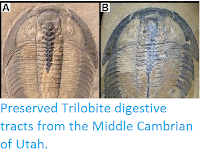Since the 1930s the Devonian marine invertebrate faunas of Colombia have been recognised as bearing strong similarities to those of North America, while those of other parts of South America are quite distinct. This has been explained by the narrowing of the Rheic Ocean during this period, which brought Colombia, on the northern tip of Gondwana, closer to Laurasia. Several Brachiopod and Bryozoan species are known from both sides of the Ocean at this time, as well as some genera of Trilobites, though Trilobites were often very widely distributed at the genus level. In 2015 a number of specimens were identified from Colombia that appeared to belong to the North American species Dipleura dekayi. However, these were too poorly preserved to be assigned with any confidence, and other species from this genus are known from South America, so the question of whether Trilobite species were capable of crossing the Rheic Ocean at this time remains open.
In a paper published in the American Museum Novitates on 21 June 2018, Maria da Gloria Pires de Carvalho of the Division of Paleontology at the American Museum of Natural History, describes a series of new Trilobite specimens from Colombia, which can be confidently assigned to the species Dipleura dekayi.
The new specimens were collected from the Floresta Formation near the village of Gutierrez, south of Floresta, by geologists employed by the Shell Oil Company who were carrying out surveys for oil in the area, and subsequently donated to the Cincinnati Museum Center Invertebrate Paleontology. These specimens comprise an almost complete internal mould 17.9 cm in length, plus a second internal mould of the cephalon (head) plus the first three thoracic segments, plus the counterpart of this second fossil, forming an external mould of the same.
Dipleura dekayi, Floresta Formation, Gutierrez area, Colombia. Internal mould, dorsal (A) and lateral (B) views. Carvalho (2018).







